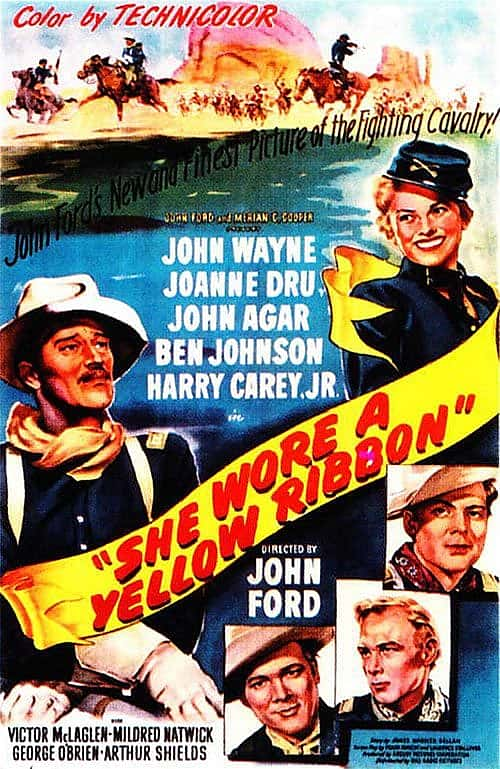James Warner Bellah: “In the Finest Tradition of the Cavalry” – Points West Online
Originally published in Points West in Winter 1999
James Warner Bellah: “In the Finest Tradition of the Cavalry”
By Dan Gagliasso, Guest Author
Ed. note: This is the second of three posts tracing the evolution of the public’s perception of the cavalry in the West from novelist Charles King to short story and script writer James Warner Bellah whose stories were then translated to the screen by director John Ford. Read post 1.
“Wherever ten or twenty of them in dirty shirt blue were gathered together—that became the United States.” —James Warner Bellah, from his screen adaptation of She Wore a Yellow Ribbon
If General Charles King was the Rudyard Kipling of the frontier army at the turn of the century, then journalist, short story writer and screenwriter James Warner Bellah inherited that distinction from him by the late 1940s. The three films famed director John Ford made from Bellah’s short stories—Fort Apache, She Wore a Yellow Ribbon, and Rio Grande—have had more influence on the modern public’s vision of the United States Cavalry during the Indian Wars than any other fictional representations of that colorful branch of the American service.
Captain Nathan Brittles, Lieutenant Flint Cohill, Lieutenant Ross Pennell, Colonel Owen Thursday, Colonel Kirby Yorke, Sergeant-Major O’Rourke, First Sergeant Quincannon—the names of Bellah’s troopers fleetingly sound in the wind like the flutter of a guidon. Even his characters and battles that didn’t make it to the celluloid screen have the same sound of rich traditions and hard won honors.
Lieutenant D’Arcy Topliff; colonels Massarene, “Jingles” Cassinger, and Chase Joplin; the fights at Crazy Man Creek and Dry Fork; and the cavalry’s more than able advisors—Stone Buffalo, Joseph Two Crow, Running Dog—all are completely fictional names with a saber clanging ring of truth, brought to life on the pages of the Saturday Evening Post, from the research and fertile imagination of the former journalist, World War I aviator, and World War II combat officer.
An eighth generation New Englander who was educated at the University of Maine, Bellah served as a pilot in the 117th Squadron of Great Britain’s Royal Flying Corps during World War I. He worked as a journalist for the New York Post in the 1930s and saw combat as an infantry officer during World War II. But it was his score of short stories on the frontier cavalry and the films made from some of them that brought him the most enduring fame.
Yet he also wrote novels like The Valiant Virginians and Blood River. His screenplays included the adaptation of She Wore a Yellow Ribbon and the screenplays for Sergeant Rutledge and The Man Who Shot Liberty Valancebased on a story by Dorothy M. Johnson. Bellah’s novella The Invaderswas also made into the first Cinemascope western film, The Command, by Warner Brothers in 1952.
Bellah’s stirring prose perhaps rings no more true than in his foray into the mind of the Captain Benteen-like first lieutenant, Flintridge Cohill inMassacre, the story basis for the Custer-like film, Fort Apache. Cohill rallies the supply train to cover after witnessing the needless destruction of two of his regiment’s companies by Cheyenne warriors. Bellah elegantly writes, “It’s not always in the book … It’s Cannae and Agincourt and Wagram and Princeton, and it’s the shambles of Shiloh. With Flint Cohill it was thirty-one men on a hog-back ridge and the thought that he’d never live now to be a general officer, but that he’d die the best damned first lieutenant of cavalry that the world could find to do the job that morning!”
Like the real Benteen at the Little Big Horn, the fictional Cohill does not die that day, but proves to be the best officer for the job. As James Warner Bellah has proven to be the foremost fictional chronicler of the Indian Wars’ cavalry in modern times.
About the author
Dan Gagliasso is a screenwriter and historian.
Post 107
Written By
Nancy McClure
Nancy now does Grants & Foundations Relations for the Center of the West's Development Department, but was formerly the Content Producer for the Center's Public Relations Department, where her work included writing and updating website content, publicizing events, copy editing, working with images, and producing the e-newsletter Western Wire. Her current job is seeking and applying for funding from government grants and private foundations. In her spare time, Nancy enjoys photography, reading, flower gardening, and playing the flute.



